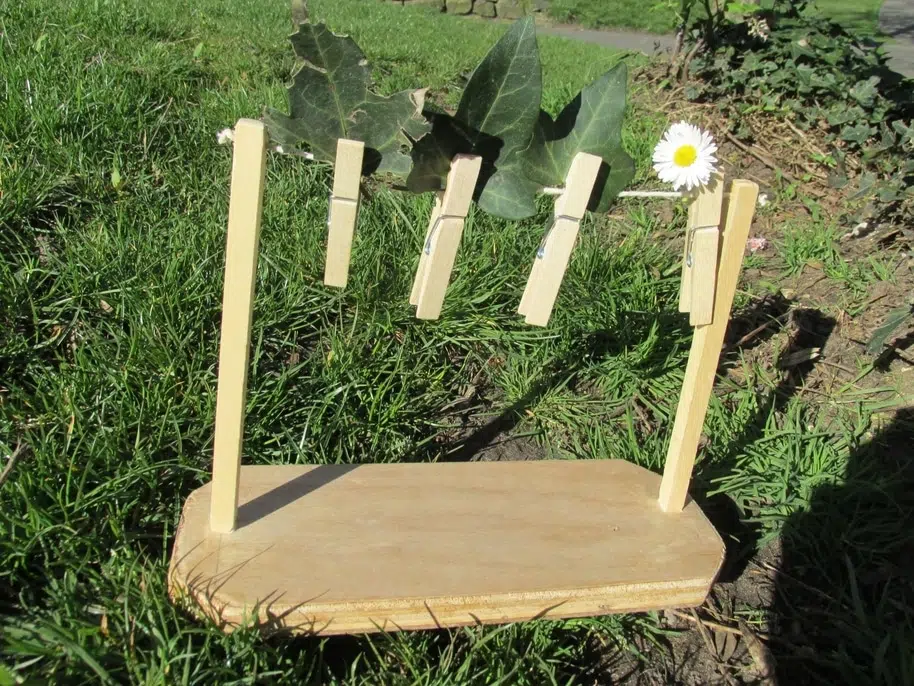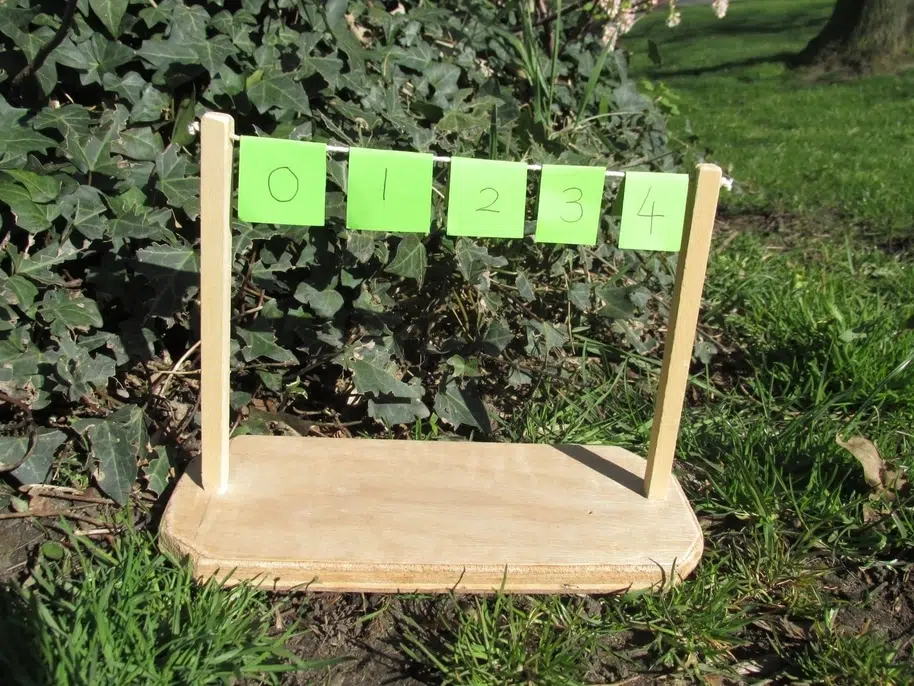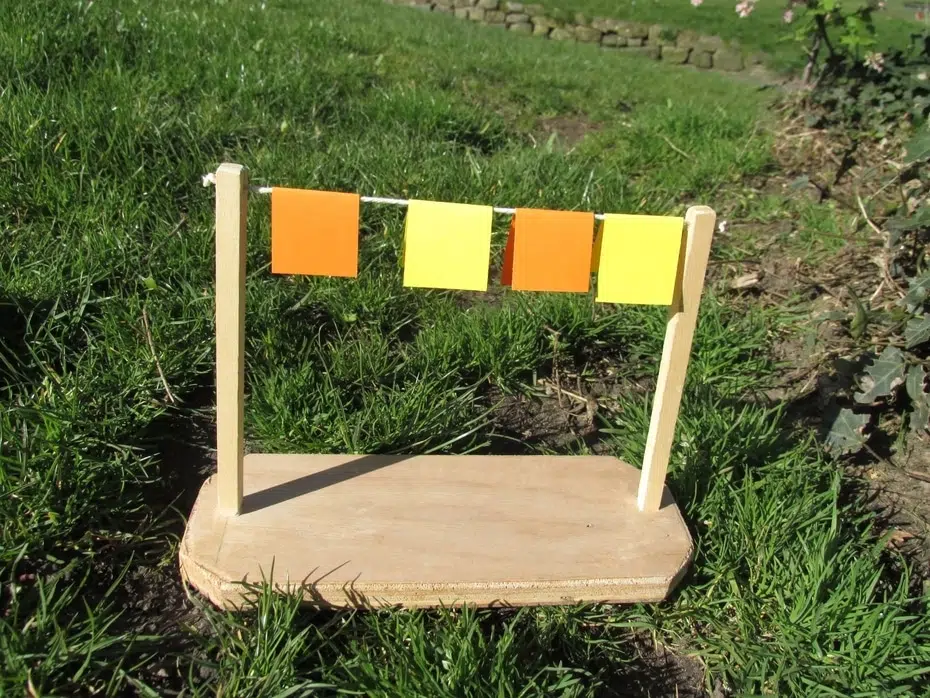Washing lines are a fantastic and simple resource to develop maths skills in a fun and play-based way. Children really enjoy pegging things on lines: it is great for their gross and fine motor skills, as well as benefitting their communication and teamwork skills.
Over ten years in the early years I have used washing lines in all sorts of ways, and I have also built different types of washing lines. In this article I want to show you some of my favourite ways of developing maths through washing lines.
So what sort of washing line maths activities are there? Children can first develop skills by matching socks, or hanging up washing and counting it. They can peg up numbers and order them. They can then learn a range of other maths skills, such as missing numbers, adding, and subtracting.
Read on for a detailed illustrated description of my favourite 14 washing line activities.

Types Of Washing Lines
The simplest way to make a washing line is just to have a piece of string that goes between two fences, or two walls. That really is all you need.
I have experimented with smaller indoor washing lines as well. These are great for smaller scale maths activities.
To make a mini washing line all you need is a piece of wood for the base. Then drill two holes in either end. Then you need two pieces of dowel or even pieces of broom handle sawn up. Superglue these into the holes. Then attach some string across the top.
The size is up to you. You can make really small ones, or ones that can stand on table. Washing lines are brilliant for many things, including maths, storytelling and literacy. You can take a look at my article all about phonics washing line games here.
Right, so you’ve got a washing line (even if it’s just a piece of string). Let’s go onto the activities you can now do.
The Activities
1. Counting Barbie’s Clothes
Children love there to be a back-story to a play activity to give it a context. Have a washing line, some of barbie’s clothes and a dice.
This is a simple matching numeral to quantity game. You roll the dice and peg up that number of clothes. Then your friend has a go. There is a bit of problem solving in this part. If there are four pieces of clothing hanging up and you roll a three, you could just take one off. This will be beyond some children though, who will take them all off, and put three back on.
2. Pegging Up The Giant’s Clothes
I brought my own clothes in when we did this. This is better done on a big washing line outside.
Tell the children that the big adult clothing is the giant’s. They really do normally believe this!
Have some other sizes of clothing as well – babies, toddlers, preschool, teenager size. This is a great activity for spontaneously talking about size as you peg things up.
You could order through size as an extension.
3. Loose Parts And Objects Hung Up On A Washing Line
There is something very intriguing for some children in finding random objects and pegging them up on washing lines.
Some fantastic things to peg up are things like leaves, sticks, wooden slices, and pompoms.

You could have pegs with numbers written on pegged up in a line.
For things like leaves, you could get the children to write numbers on to them. You could order the leaves numerically. Or, particularly in Autumn, you can put the leaves in a pattern – for example red, brown, red, brown. You could add with the leaves, such as three red add 2 brown.
Items like sticks are great to find around the setting and try to peg up on the line. Again you could make patterns, or you could hang them in size order.
Pieces of material could be pegged up in a pattern, or again for some sort of numerical calculation. It could be 5 pieces of blue ribbon, add 3 pieces of pink.
All of these ideas using natural materials are really engaging, and get the children thinking and interacting with their environment all at the same time.
4. Ordering Numbers
For this you can peg numbers onto the washing line.
Even easier, though, is to use little pieces of card that are folder over to make an upside down ‘v’ shape.
You can order 1-3, or 0-5 or 0-10. To make it harder order numbers that are not in strict counting order, for example 3,5,6,7, 9,12.
There are many different ways to order numbers that you can find out a lot more about in this article.
To make it easier have a simple number line for them to refer to.

5. Patterns With Colored Card
This uses the small pieces of card again. This is even easier than using pegs, and extremely visual.
To extend, more able children can try to create more complex patterns. For example, red, blue, green, red, blue, green…Or it could be red, red, yellow, red, red, yellow.

Other things that are great for patterns are socks, or 2D shapes pegged up.
6. Addition
This is one of my favourite ways of introducing or practicing simple addition.
Because using washing lines is very visual as well as active, it promotes learning through a range of learning styles.
Use two different colours of the bent card. If you are going to be attempting to read addition sentences then you can give the children the calculations written down – e.g. 4 + 3. Use 4 of one colour and 3 of another. You could write the two numbers in the matching colours to make it easier.
Another way is just to get them to pick two numbers and match these with the different colours and add up what they get.
More skilful children could roll two dice, make the calculation on the washing line and try to record their calculation.
7. Subtraction
Same as addition, subtraction works well because it is really clear how to ‘take-away’. It is both practical and visual.
Give the children subtraction sentences, such as 6-4. They start with the first number and take away the second number. Little pieces of card work well again. Or you peg something up like pictures or socks.
A fun, active subtraction strategy.
8. Missing Numbers
Missing numbers works really well on washing lines because they are so easy to manipulate.
Children could create their own challenge. Order some numbers, but then turn one around or take it off. Which as gone missing?
9. Pairs Of Socks
This is a really classic activity for a good reason. Lots of children instinctively want to do it. A big pile of random socks is what is required here. Lots of different sizes are good – adult, child, teenager, baby. Also numerous different colours work well.
Match the socks and peg them up! A great activity for talking naturally about different sizes, and using and extending all the different vocabulary of length.
More able children could attempt to count them in twos.
10. Pegging Up Gloves – Counting How Many Fingers
This is an excellent multi-level activity. You can simply start by pegging up some gloves and trying to count how many there are. You can also count how many fingers they have.
It can extended, however, in different directions. This is a good activity for getting children to practically count in 5s or 10s. If there are six gloves on the washing line, you can count in 5s six times, or you can count in 10s three times.
Number bonds are also possible this way. For number bonds to five, you need one glove. If you grab some of the fingers, how many fingers are left. For example, grab two and there are three fingers still showing.
11. Counting Song Pictures
This is a great thing to do on a class washing line. Have some pictures that go with one of their favourite counting songs – for example, five cheeky monkeys from the Five Cheeky Monkeys song.
Peg the monkeys on the line and count them. Then all sing the song, and when one monkey has to go to see the doctor, take it off the line. Count how many you have got again. Repeat throughout the song. The visual really helps develop the concept of one less and accurate counting.
This can be extended in the children’s play. If you have several sets of pictures from number songs that they have access to then they could attempt to peg them on the line and sing the songs through their own choice.
12. Recording Number Challenges, And Pegging Up recording
Washing lines are a great way of displaying children’s recording of a number challenge.
For example, the ‘Feed the Monster’ game. Have a container (a plastic cup will do) that has been jazzed up to look like a monster. Also get an egg timer, some tweezers, and some ‘food’ for the monster – pompoms work well for this.
One at a time the children take it in turns to put as many pompoms (food) into the monster cup as they can in the time limit (e.g. 20 seconds). When finished they count how many they have got and write it on a piece of paper.
They can then peg their piece of paper on the washing line! A great way to be proud and clear about what you have done.
There are sorts of games like this that develop 1 to 1 correspondence in a fun way. To find out more about what 1 to 1 correspondence is, and the best ways to teach it, then take a look at this.
13. Number Bonds To Five Or Ten
Number bonds work really well on a washing line. The mini-lines are great for it. Have a selection of two different colours of little pieces of card.
Tell the children they can only put five cards on the line, but how many ways can they do it?
This is a very open-ended kind of problem-solving, and a really visual way of understanding number bonds.
14. Drawstring Bags With Objects Inside
Have some drawstring bags that are tied to the washing line. Put some numbers on the drawstring bags.
The children can try to find that number of objects and fill the drawstring bags with the quantity that matches the numeral.
15. Use As A Number Line
Have numbers on different kinds of pictures. Can children peg them up in the right order?
They can peg them in different directions.
Higher ability children may be able to sequence them in 2s, 5s or 10s.
A trickier skill, also, is starting from a number that is not 1. Try starting at 3 or and sequencing the numbers from there.
16. Massive Washing Lines V Little Ones
There are great benefits to using washing lines of very different sizes. Large ones made from rope or really strong string are great for hanging all sorts of heavy things on. This is one of the activities in my article Outdoor Maths Games – 50 Ideas That Work!
Children are often intrigued by tiny things, and mini-washing lines will be no exception. These are fantastic for fine motor and for getting children focussed on a delicate task.
17. DIY Washing Lines
There are many ways of making the lines, and there are lot of DIY hacks you can use as well.
One great idea for a simple washing line is to use a clothes maiden, either a large or a small one.
You can also use a drying rail from a radiator.
I have recently visited a nursery that had created a washing line with two broomsticks stuck into concrete inside two big plant pots. The line was outside permanently for the children to use.
Another great option is a small table upside down. Tie string between the legs of the chair for the children to peg items onto.
18. Patterns On Pegs
Pegs of different colours are great for this. You simply try to make a pattern – for example, red, blue, red, blue etc.
It is great for them to use pegs because they also develop fine motor control and many of the muscles that you use for writing. Also this is a very visual and active way of creating patterns.
19. Finding Objects And Counting Them
This is a great, simple task. You go round the outside area looking for objects, bring them back to the line and peg them up.
Then you count how many you have. How many would you have if you had one more? What about if you took one off?
20. Counting Songs On The Line
For this you need a few pictures or objects. If the song is 5 Little Ducks, then you need five ducks pegged up.
Sing the song and one duck swims away. Take the duck off and count how many are left. Get them to show it on their fingers and then sing again. This is a great way of introducing one less.
You can extend this by getting the children to draw their own pictures and singing the songs independently.
Other Ways You Can Use Washing Lines
For storytelling – Children can order pictures from a story that they know well. They could also just put picture stories up onto a washing line and then put tell the story they have created.
For phonics – Children can peg up sounds or words, and read words or sentences.
For mark-making – Draw pictures or attempt mark-making and peg it up onto the washing line. Children can draw insects, pirates, family members, or whatever else they choose.
Conclusion
Washing lines are one of the simplest yet most effective tools for teaching simple maths. Children love pegging things on, and it is great for comparing size and ordering in lots of different ways.
Many of the central skills of early maths can be developed through washing lines, such as counting, addition, subtraction, number bonds and ordering. Having a story behind activities, or have them link to a theme or interests can really enhance the children’s experience.
Good luck with the washing line maths!
If you’ve found this useful, then why not check out one of these articles:
